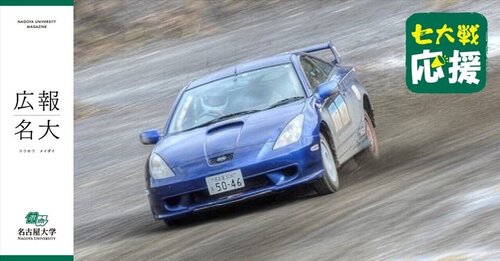Tucked behind the athletic fields on the Higashiyama Campus lies a garage lined with cars, where members of the Nagoya University Automobile Club—one of the more unique athletic organizations at Nagoya University—work diligently to maintain their vehicles. Several club members shared insights about their usual activities as they prepared for the inter-university motorsport competition at the Seven Universities Athletic Meet in September 2024.
Racing on a Budget: 100,000 Yen and a Dream
The club typically meets on Friday evenings, with members arriving one by one in their cherished rides. In the garage, they were checking engines and changing tires as the competition approached. “Since our cars are used vehicles, routine maintenance and inspections are essential,” explained club captain Ryūya Doi (fourth year, School of Engineering). “We actually spend more time maintaining the cars than driving them!”
New members begin attending driving school immediately after joining and typically obtain their licenses during summer break. By fall, most first-year members purchase their own cars. Thanks to deals from senior members or other university automobile clubs, they can usually acquire a vehicle for around 100,000 yen (approx. $700 USD). This represents a significant expense for students, but they manage to save sufficient funds by working part-time jobs. Doi balances multiple jobs related to automobiles, such as working at a rental car shop, driving trucks, and performing car inspections.
Yūsha Yazici (fourth year, School of Informatics) admitted he was not particularly interested in cars before joining the club. “I was surprised to read in the club pamphlet that there were college students who owned cars and even competed in races. I thought it seemed mature and cool,” he said of his decision to join.
After joining in April, Yazici quickly learned about motorsports and cars from the other members and bought a car by May. “On my very first run on the track, an experienced member told me, ‘Hey, you have natural talent!’ I was thrilled. Looking back, I was actually terrible, but that comment made me feel like I really was skilled,” he laughed. Since then, he has gotten hooked on motorsports.
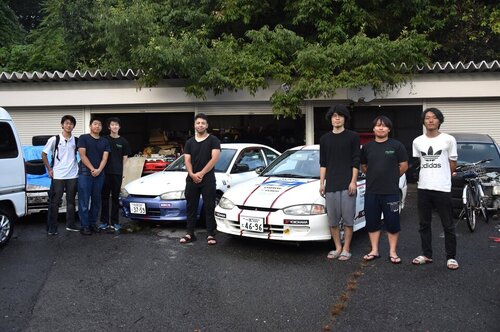 Club members at the garage where they perform vehicle maintenance
Club members at the garage where they perform vehicle maintenance
Honing Driving Skills on “Track Days”
Training takes place on “track days,” held on rented motorsport circuits or ski resort parking lots during the off-season. These events are often organized by alumni or adult racers on the weekends, and Nagoya University club members typically attend once a month.
After just two or three track days, the tires wear out to the point they can no longer be used in official events. “Replacing them costs 50,000 to 100,000 yen per set, and we are required to use new tires for competitions. That makes it difficult to participate in track days regularly,” explained Doi. To compensate, the members study videos on YouTube and install cameras in their cars to analyze their own driving. “Reviewing one’s own driving is crucial. I compare it with footage of skilled racers to prepare for the next run,” Doi added, demonstrating his commitment to continuous improvement.
In the spring, new members begin in the passenger seat, learning competition driving techniques, like how to handle the accelerator and brakes, from senior members. Hands-on driving practice behind the wheel typically starts around the fall. It is rare for first- and second-year students to win races; only in their later years do they become contenders for top positions. However, graduation arrives just as racing becomes truly enjoyable, so many continue participating even after entering the workforce. One of the club’s distinctive features is its strong alumni network.
“A lot of our alumni work in the automotive industry or are still active racers, so they give us tips when we meet on track days,” said Doi, who also hopes to work in the automotive field. “Ideally, I would like to join a company with a racing team so I can continue competing after I graduate.”
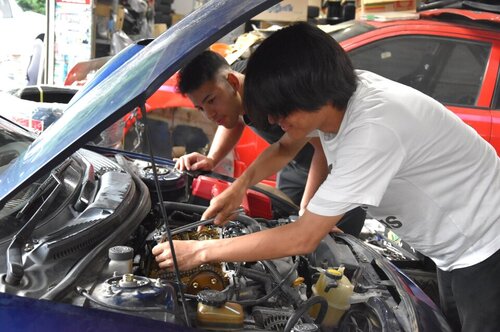 Senior members teach juniors how to inspect and replace damaged parts
Senior members teach juniors how to inspect and replace damaged parts
Striving to Avoid Last Place at the Seven Universities Athletic Meet
The motorsport events at the Seven Universities Athletic Meet include two race formats: “gymkhana,” which is raced on paved tracks, and “dirt trial,” held on unpaved, dirt courses. Both are time trials where drivers compete for the fastest completion time through a set course. In gymkhana, the goal is to drive as cleanly as possible without making the tires slip, while dirt trials involve a more aggressive, drift-heavy driving style due to the loose surface.
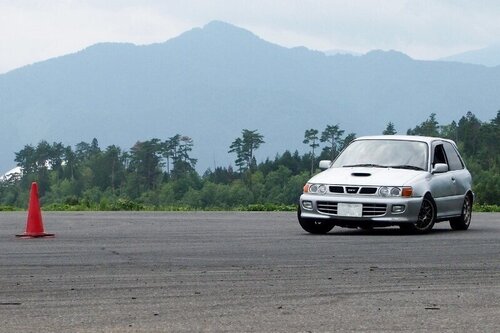 In gymkhana, course layout changes significantly depending on cone placement. For sharp turns of 180 or 360 degrees, drivers lock the rear tires with the handbrake and accelerate through the corner without losing speed
In gymkhana, course layout changes significantly depending on cone placement. For sharp turns of 180 or 360 degrees, drivers lock the rear tires with the handbrake and accelerate through the corner without losing speed
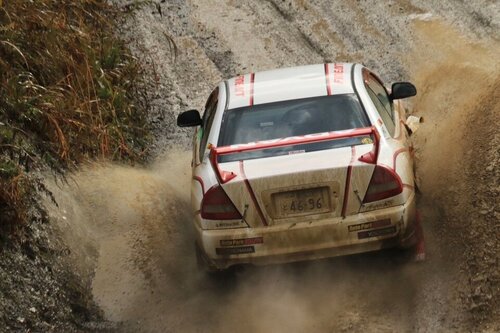 In dirt trials, success depends on maintaining speed while drifting through corners and adapting to a wide range of gravel conditions
In dirt trials, success depends on maintaining speed while drifting through corners and adapting to a wide range of gravel conditions
In 2023, Nagoya University finished in last place. Doi manged to place second in the gymkhana event but lost ground in the dirt trial. “I hit a flooded section caused by heavy rain the day before and fell out of the top ranks,” he recalled.
For the 2024 competition, the club’s goal was to avoid finishing last. Yazici, aiming for a spot on the podium, had recently overhauled his car with new suspension, tires, and brakes. “Technically, it is the same car as last year, but what is under the hood is brand new. It is in great shape, so I am really excited.”
For the two fourth-year students, this would be their final competition as part of the club; expectations were high for a strong, memorable finish.
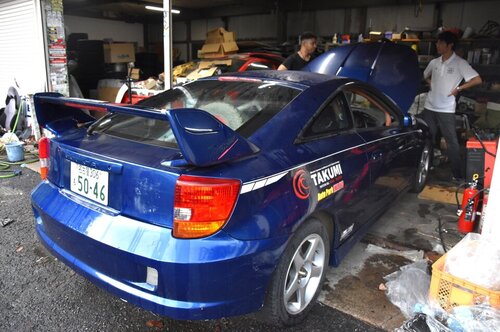 Yazici will drive a Toyota Celica—the only dedicated race car in the Nagoya University Automobile Club—in the dirt trial
Yazici will drive a Toyota Celica—the only dedicated race car in the Nagoya University Automobile Club—in the dirt trial
Related Links
Nagoya University Automobile Club’s website, X (formerly Twitter), and Instagram
This article was originally written in Japanese by Tatsuhiko Maruyama for the “Public Relations Meidai” web magazine and published on September 5, 2024. Unless otherwise stated, photos were taken by the author or provided by the Nagoya University Automobile Club. The Nagoya University International Communications Office has translated and edited it for clarity while preserving the original content’s intent. Certain information might be outdated. For the original Japanese version, please see here.

